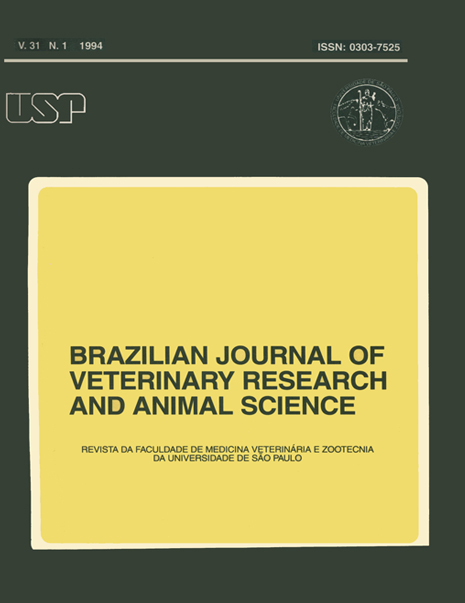Reproductive biology of donkey. II. Physycal and morfhologycal characteristics of semen
DOI:
https://doi.org/10.11606/issn.1678-4456.bjvras.1994.52049Keywords:
Reproduction, Donkeys, Semen, MorphologyAbstract
Seminal characteristics of six donkeys of the "Pega" breed, ranging from 3 to 9 years of age were studied. Between October 1988 and April 1989, seventy (70) ejaculates were collected by using artificial vagina, twice a week. The following average values, for the parameters studied were found: total volume (59,88 ± 15.54 ml), gel volume (8,19 ± 4.07 ml), total spermatozoal motility (81,93 ± 6,27%), progressive motility (72,86 ± 7,20%), sperm vigor (4,63 ± 0,49), sperm concentration (444,11 ± 182,72 x 10³/mm³), total sperm number per ejaculate (24,88 ± 9,59 x 10 9), total abnormal cells (15,60 ± 3,62%), major defects (8,55 ± 2,14%) and minor defects (7,04 ± 2,56%). These results were quite similar to that reported in the literature for donkeys. Compared with the values found by other authors lor stallions, both species are very similar, differing only in some aspects. The total volume of jackass ejaculate was inferior, however, since the gel occurrence was much lower than in stallions, the "sperm-rich" fraction volume was approximately the same. The sperm concentration and total sperm number per ejaculate were higher for asses. Furthermore, the parameters of spermatozoal motility and vigor demonstrated that jackass semen was, almost always, of superior quality. In artificial insemination programmes, these characteristics would indicate the possibility of higher number of individual-doses per ejaculate and better freezability levels.Downloads
Downloads
Published
1994-03-01
Issue
Section
ANIMAL PATHOLOGY
License
The journal content is authorized under the Creative Commons BY-NC-SA license (summary of the license: https://
How to Cite
1.
Morais RN de, Mucciolo RG, Viana WG. Reproductive biology of donkey. II. Physycal and morfhologycal characteristics of semen. Braz. J. Vet. Res. Anim. Sci. [Internet]. 1994 Mar. 1 [cited 2025 Apr. 5];31(1):49-57. Available from: https://revistas.usp.br/bjvras/article/view/52049





